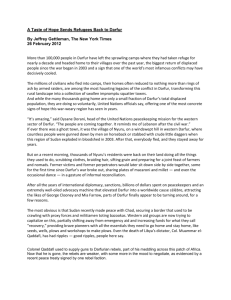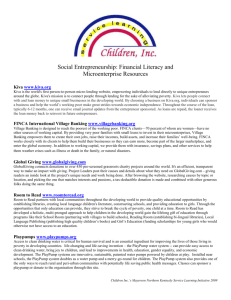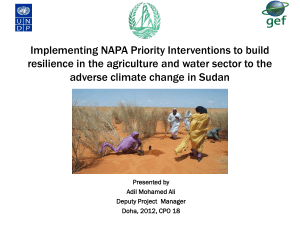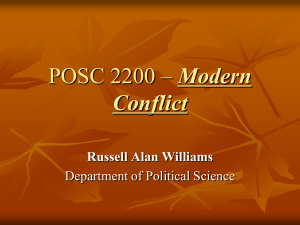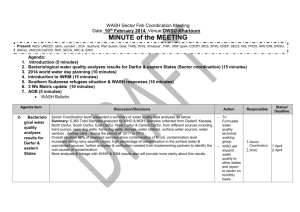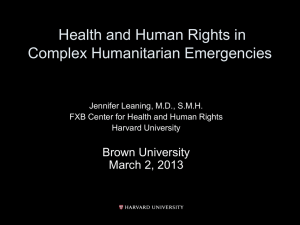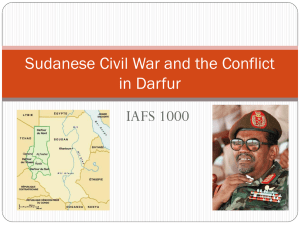Overview of Conflict Dynamics and Conflict Analysis in 2013
advertisement
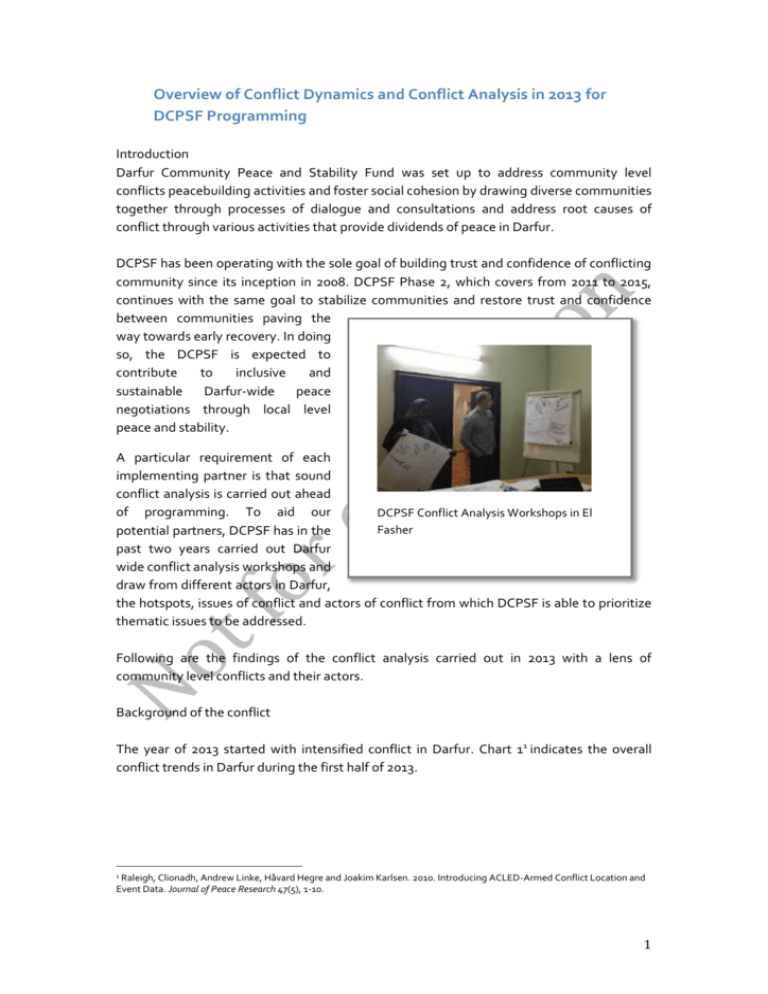
Overview of Conflict Dynamics and Conflict Analysis in 2013 for DCPSF Programming Introduction Darfur Community Peace and Stability Fund was set up to address community level conflicts peacebuilding activities and foster social cohesion by drawing diverse communities together through processes of dialogue and consultations and address root causes of conflict through various activities that provide dividends of peace in Darfur. DCPSF has been operating with the sole goal of building trust and confidence of conflicting community since its inception in 2008. DCPSF Phase 2, which covers from 2011 to 2015, continues with the same goal to stabilize communities and restore trust and confidence between communities paving the way towards early recovery. In doing so, the DCPSF is expected to contribute to inclusive and sustainable Darfur-wide peace negotiations through local level peace and stability. A particular requirement of each implementing partner is that sound conflict analysis is carried out ahead of programming. To aid our DCPSF Conflict Analysis Workshops in El Fasher potential partners, DCPSF has in the past two years carried out Darfur wide conflict analysis workshops and draw from different actors in Darfur, the hotspots, issues of conflict and actors of conflict from which DCPSF is able to prioritize thematic issues to be addressed. Following are the findings of the conflict analysis carried out in 2013 with a lens of community level conflicts and their actors. Background of the conflict The year of 2013 started with intensified conflict in Darfur. Chart 11 indicates the overall conflict trends in Darfur during the first half of 2013. 1 Raleigh, Clionadh, Andrew Linke, Håvard Hegre and Joakim Karlsen. 2010. Introducing ACLED-Armed Conflict Location and Event Data. Journal of Peace Research 47(5), 1-10. 1 Chart 1: Conflict Trends in Darfur Jan-June 2013, Source: ACLED Conflict Trend 100 90 80 Violence Against Civilians 70 Riots/Protests 60 Non-Violent Transfer of Territory 50 Non-Violent Activities 40 Battle-rebels overtake territory 30 Battle-no change of territory Battle-Government regains territory 20 10 0 January February March April May June Based on data from Armed Conflict Location & Event Dataset (ACLED), the number of incidents in 2012 was 351 while in 2013 the number only for the first 6 months reached 359 and has already exceeded the annual incident numbers in 2012. The number of fatalities (2,382) for the first 6 months in 2013 was more than double the annual figures in 2012 (1,068). Charts 2 and 3 showing number of Incidents and number of Fatalities in Darfur, Jan-June 2013, Source: ACLED Number of Incidents in Darfur Total Numbers of Fatalities 100 600 80 500 60 400 40 2013 20 2012 0 300 200 100 2013 2012 0 Considering such changes, the TS conducted a conflict analysis in all five Darfur states in June/July 2013. The main objectives were to update the conflict analysis done in 2012 and identify prioritized hotspots, conflict issues, actors and both institutional and proxy causes of conflicts. 2 Hotspots Through the conflict analysis, identified hotspots in 2012 (brown shade) and 2013 (red circle) are indicated in Map 1 (annexed here). In 2012, the hotspots were analyzed according to localities as opposed to specific villages because the conflict mapping workshop participants were of the view that issues were similar within the localities. Based on the generality of that, in 2013, the conflict workshops sort to identify the prioritized hotspot areas as opposed to localities and dig deeper into the root causes of conflict in these hotspot areas. New hotspot areas identified in the 2013 conflict analysis include the Abu Jabra area and the 14-mile stretch in East Darfur. As the following data from ACLED indicates, intensified conflict particularly in South, North and West Darfur supports many hotspots identified in those states through the conflict analysis in 2013. The general findings from conflict analysis can be found in the text box detail in Map 1: Actors and Issues (higher-resolution map available for detailed reading). Charts 4 and 5 showing number of incidents per Darfur state in 2012 and 2013, Source: ACLED Number of Incidents per State (2012) 50 45 40 35 30 25 20 15 10 5 0 Central Darfur North Darfur South Darfur West Darfur East Darfur Number of Incidents per State (2013) 50 45 40 35 30 25 20 15 10 5 0 Central Darfur North Darfur South Darfur West Darfur East Darfur Root and structural causes Structural Causes of Conflicts In the conflict analysis in 2013, different types of conflicts were identified initially, which are mainly categorized as conflicts between the Government and rebel groups, and tribal conflicts. For both types of conflicts, the underlying structural causes of conflict have not changed. For the former conflicts is manifested in economic marginalization, governance and political representation and unequal distribution of services in Darfur compared to the rest of Sudan. The latter conflict at the community level is primarily manifested in competition over access and use of scarce natural resources and local power relations that includes land ownership, access to natural resource particularly along migratory routes and grazing land, competition over power among different tribal groups. A complexity of conflicts overlaps these two types of conflicts. The conflict at the community level became 3 more complex and complicated due to the increased politicization, manipulation and overlap between the local resource based and tribal conflicts with the macro level political conflict between the government and rebel groups. The immediate impact is that almost every tribal conflict at local level is labeled and classified as either backed up by the government or rebel groups. Other causes of Conflict Crop destruction Conflict over crop destruction between the Abala and farmers (Gimir), Fur and Zagawa continued in 2013 in North Darfur, as did many other states, making the DCPSF interventions along the three main migratory routes in North Darfur, West Darfur and South/East Darfur, very relevant to communities. Pastoralists were seen to destroy farms before the ‘Talaga’ season – February 7th when animals are allowed to start grazing on harvested farms. This increased the tensions between farmers and pastoralists. Other examples include Mesteri where conflict between farmers and nomads during the harvesting and rainy seasons continued to be witnessed. Generally as is witnessed in certain parts of Habila, Kornoi and Njory as well as other parts of Darfur, pastoralists as well as farmers encroach on each other’s land for their livelihood purposes. In such cases, the farmers block migratory routes or the pastoralists graze on farming land. These conflicts continue to be a problem where native administration is weakened to the extent that disputes of these nature cannot be resolved quickly. Land occupation Conflicts across Darfur continued along land occupation. Examples include the Jebel Gubba area 5 km east of Kutum where there are populations from Niger and Chad. The main actors in this occupation are the foreign settlers who are armed. Due to the difficulty of disarming such groups, and the continued polarization of tribes along conflict lines makes the situation more complex. A similar phenomenon was reported in Sindu, Sandol, Dambar and Wasatni in Central Darfur where populations from neighboring nations Niger, CAR and Chad have settled. In South Darfur on the other hand there was the settlement of the Salamat tribe from Rehed El Berdi to Dogodusa, which escalated conflict between the Salamat and the Misseriya. In Taweng, West Darfur, the Massali are new comers occupying land and causing the displacement of farming tribes. Unsettled border demarcations In Kulbus in West Darfur, the lack of clear boundaries between Chad and Sudan continues to influence the conflict between the Gimir and the Zaghawa verses the frequent armed pastoralists from Chad. The East Darfur border along the 14-mile stretch also witnesses conflicts between the South Sudan Dinka Mulual tribes and the Rezigat over natural resources such as pastureland and water. This is further made complicated by the SPLA verses the SAF actors since the CPA was never fully implemented. As such claims of territorial ownership continue. 4 The eastern border between West Kordofan and East Darfur experiences the same issues of lack of proper demarcation of the state borders. This continues the seasonal conflicts between the Misseriya and the Rezigat over pastureland and water. In Central Darfur, the migration of the Salamat from CAR as well as others from Niger and Chad continues to influence the conflict here. In the recent past, Salamat from Darfur fled back to CAR, as well as back-up from CAR to fight within Darfur when the conflict between the Salamat and the Misseriya erupted earlier in April this year to fight both the Taaisha and the Misseriya. Proximate Causes of Conflicts The new trends of conflict identified in 2013 at the proximate causes are detailed below. Conflicts over gold mining in North Darfur: This conflict started in late 2012 between the Beni Hussein and the Northern Rezigat in Jebel Amer. The structural cause of this conflict is land ownership (hakura vs. government ownership). Finding gold in this area attracted people from different places in Darfur and created a new motive for conflict on the surface. This conflict also marked the start of a new dynamics of Arab-Arab conflict. Conflicts between the Government and Arab tribes allied with the Government of Sudan (GoS): Several incidents of open fire by militia towards the GoS were witnessed in market places in Darfur. This type of conflict is partially caused by the current economic hardships in Sudan. Escalation of inter-tribal clashes Arab/Arab: In addition to the Arab verses Arab conflict between the Bagara and Abala in Central Darfur last year, there was additional conflict in North Darfur between Beni Hussein and the Rezigat in Jebel Amer over gold mining, the Sallamat and the Misseriya in Dougoudusa and Shatai in South Darfur due to displacement of the Salamat as well as conflict over pasture land, and in Rahaid El Berdi in South Darfur between the Sallamat, Taaisha and Misseriya over historical issues over land claims between the two tribes. In East Darfur, there was the conflict between the Rezigat, Maalia and Misseriya in Abu Jabra area that are mostly due to historical reasons of land ownership and tribal leadership recognition. The causes of these conflicts were mostly competition over power as well as tribal polarization along political lines. See more details in Map 1 showing the actors in hotspots. Presence of Armed groups SLA/AW, JEM and other SLAs continued in looting, banditry and general insecurity in Darfur. This particularly intensified due to the absence of a strong rule of law in many locations to contain the rebel movements. In East Darfur, Labado and Muhajiriya localities, SLA-MM and the GoS are the main actors in armed conflict leading to massive displacement of communities. SPLA and the SAF are the main actors along the 14 mile stretch. In West Darfur SLA-AW in conflict with GoS became notable after SLA-AW took over Golo in December 2012. In Jebel Moon area, JEM and GoS were reported to have clashed. 5 In South Darfur, the SRF (SLA-MM, SLA-AW) continue to be in conflict with GoS especially in Al Salam Camp, Abga Rajel, and Taasha, Kidineer, Bale Essaref, Turb and Keila areas. In North Darfur, SLA clashed with GoS in the Kebkebiya, Saraf Omra and Seraif areas making the place inaccessible and increasing food insecurity as well as causing mass displacement of populations. The same is true in Shagil Tobaya, Darel Salam areas where GoS and SLA-MM are known to clash due to the collapse of peace talks. These same movements are reported in Tawila areas, Klaimedo, Wadaa and Khazan Jedid. Generally, where we have rebel strongholds in constant conflict with GoS, there is insecurity, and mass displacement of communities, which deteriorates livelihood assets and leads to new dependency of humanitarian aid, pushing populations backwards from early recovery. Enabler Both old and new conflicts were facilitated by high proliferation of arms and absence of or weak rule of law in Darfur. Those enablers were identified by both 2012 and 2013 conflict analysis. This was further compounded by the lack of livelihood opportunities especially for the youth making it easy to recruit them into the various militia movements. Consequences The new conflicts had significant consequences. Jebel Amir conflict had a spiral effect in West and Central Darfur in the Um Dhukun area, and further escalated to tribal conflict between the Northern Rizigat and the Misseriya leading to high fatalities in the first half of 2013. This spiral effect was due to similar tribal compositions in both West and Central Darfur (Northern Rezigat and Beni Hussein) that became compounded by strong tribal alliances between the Rezigat and Salamat verses the Misseriya as well as the Misseriya alliance with the Taaisha verses the Salamat. As a result, this led to a new trend of flight of population from Central Darfur to Chad, which included both former Chadian refugees (returnees) and new Darfuri refugees into Chad. Peace capacity/drivers In Darfur, despite the escalation of conflict, there still exist strong community capacities to support reconciliation and peacebuilding processes including a culture of solidarity, existence of strong civil society organizations including academic institutions such as Peace Centers of Darfur Universities, women’s groups, and native administrations. These peace drivers/engines are assets that exist within a society to reduce conflict and build peace. They operate at different levels: state, local, community and could be formal or informal, and should be strengthened for the resilience of a society to resolve conflicts. These community structures continue to be supported and strengthened to lead these peacebuilding processes. The DCPSF thus further needs to identify these community structures and use them as peace engines that could be replicated in other areas. Some of the peace dividends interventions could be used in supporting coexistence between communities especially when the conflict is primarily over scarce resources such as water. 6 While the DCPSF approaches to support community’s existing capacity for peacebuilding is still very much in need, the current conflict trend of increasing tensions and incidents is also posing reconsideration of the DCPSF’s approaches since the DCSPF’s overall goal is to support inclusive and sustainable Darfur-wide peace negotiations. The DCPSF TS will explore to link local peace structures and committees to state structures for sustainability and viability. The local conflict is organically linked with the macro level based on the conflict analysis and thus the link between the structures is important. DCPSF Targets in 2013 Based on the above conflict analysis, it is critical to continue to address: 1. Intertribal conflicts, especially the renewed Arab vs Arab conflicts identified above. 2. Root causes of conflict along Migratory routes identified in 2012 – farmers, pastoralists, IDPs and host communities identified in 2012 3. The new hotspot areas identified in 2013 MAP 1: Actors of Conflict in Hotspots identified for DCPSF Interventions 7 8

